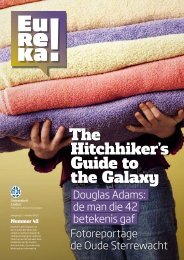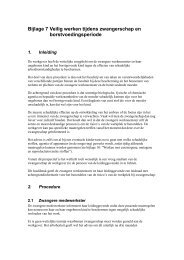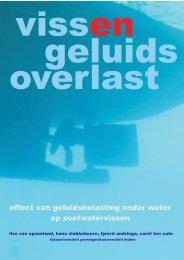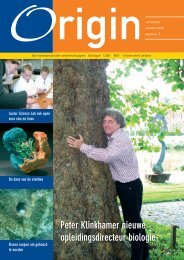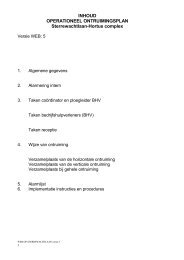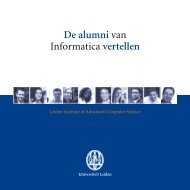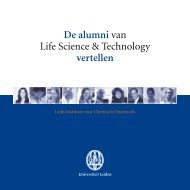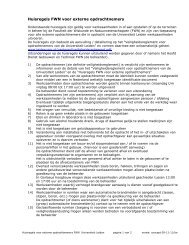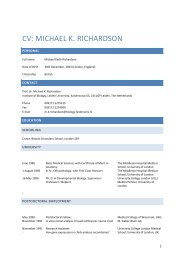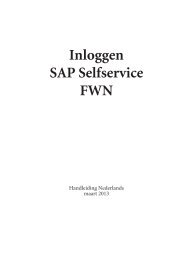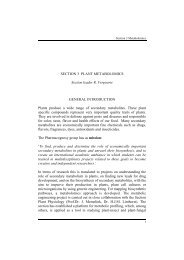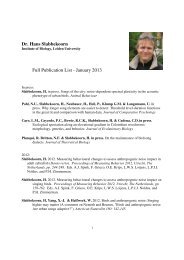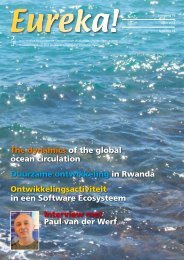infinite Beauty - Faculteit der Wiskunde en Natuurwetenschappen
infinite Beauty - Faculteit der Wiskunde en Natuurwetenschappen
infinite Beauty - Faculteit der Wiskunde en Natuurwetenschappen
You also want an ePaper? Increase the reach of your titles
YUMPU automatically turns print PDFs into web optimized ePapers that Google loves.
22<br />
sPeCial<br />
origin - universiteit leid<strong>en</strong><br />
Interestingly, the anatomical theatre of Leid<strong>en</strong> was<br />
built after the late medieval ages. The medieval ages<br />
are not acknowledged for their physical care and beauty.<br />
Fascinatingly, “Perfect beauty was in the old days just<br />
as unreachable as it is nowadays” as is phrased by<br />
Karine van ‘t Land, who is a junior sci<strong>en</strong>tist studying<br />
the history of medieval medicine. Therefore, the anatomy<br />
of the human body was drawn in an idealistic<br />
manner without any imperfections and according to<br />
the principles of beauty during that frame of time.<br />
Nowadays, we will look<br />
at these drawings as if<br />
they are not realistic<br />
and not true-to-nature<br />
at all, comparing this to<br />
the pres<strong>en</strong>t day available<br />
knowledge and information.<br />
However, how<br />
can we judge objectively<br />
in this point of time if these late medieval age images<br />
were not realistic?<br />
Today, we look towards old illustrations as pieces of<br />
art. We are pres<strong>en</strong>ting these illustrations to observers<br />
through exhibitions and they serve in the first place to<br />
amaze and interest the observer. In the meantime, the<br />
observer is trying to see through the meaning and the<br />
reality of the image. The question is whether these observers<br />
are trying to un<strong>der</strong>stand the cont<strong>en</strong>t reality of<br />
the image or are they just seeing what they want to see,<br />
while looking for their own reality in the image? Thus,<br />
we recognise our own reality in the observation of the<br />
<strong>en</strong>vironm<strong>en</strong>t, and this is in ess<strong>en</strong>ce the ph<strong>en</strong>om<strong>en</strong>on<br />
called ‘art’. Moreover, this implies that mo<strong>der</strong>n day<br />
images exhibited anywhere to a public are ess<strong>en</strong>tially<br />
art as all the observers create their own reality wh<strong>en</strong><br />
trying to interpret the illustration.<br />
However, these t<strong>en</strong> images cannot be observed in full<br />
and show only a piece<br />
of the complete item.<br />
Therefore these items<br />
could become ev<strong>en</strong><br />
more like art and create<br />
their own reality,<br />
which oft<strong>en</strong> calls for<br />
emotions and a feeling<br />
of beauty in the observer.<br />
The exquisit<strong>en</strong>ess of these images is in harmony<br />
with sci<strong>en</strong>ce as sci<strong>en</strong>ce is a reconnoitring expedition<br />
towards novel knowledge of the reality on the basis of<br />
affirming facts. To address this issue, it is fair to assume<br />
that art and sci<strong>en</strong>ce synchronise by the fact that<br />
both disciplines converge towards recreating reality,<br />
yet each from a differ<strong>en</strong>t angle.<br />
The t<strong>en</strong> items are part of the new exhibition of Museum<br />
Booijmans van Beuning<strong>en</strong> in Rotterdam, for which<br />
sci<strong>en</strong>tists in Natural Sci<strong>en</strong>ces were asked to deliver sci-<br />
’art and sci<strong>en</strong>ce synchronise by<br />
the fact that both disciplines converge<br />
towards creating reality, yet from<br />
a differ<strong>en</strong>t angle’



